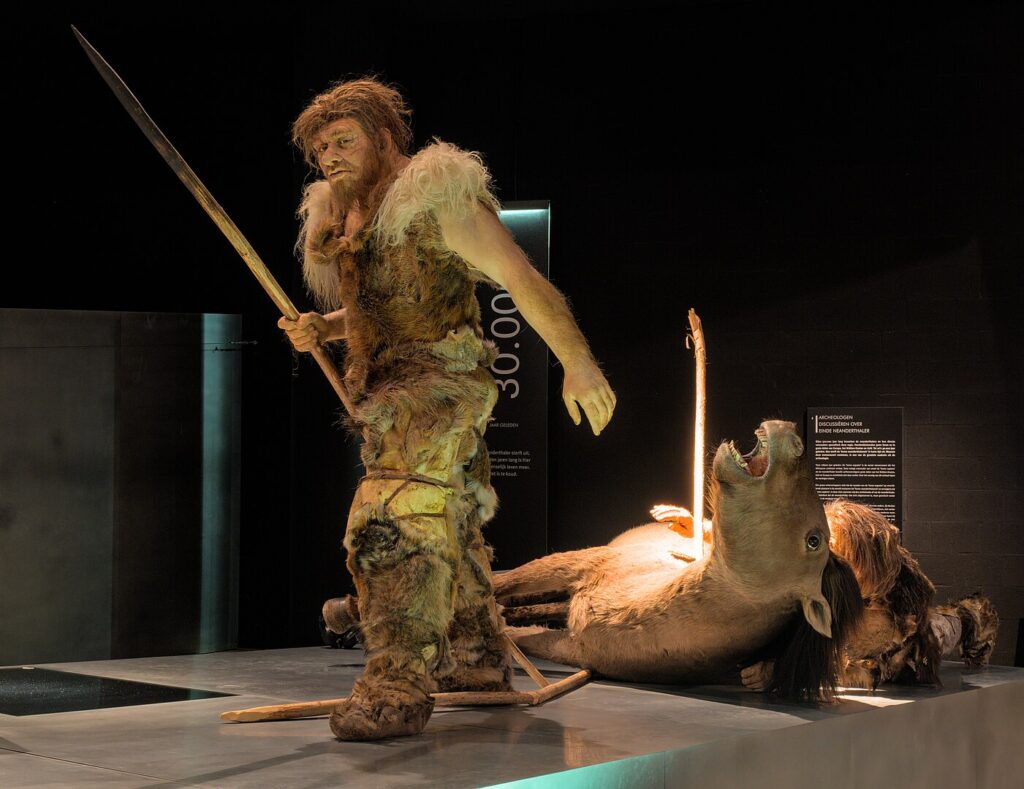
Reconstruction of a Neanderthal hunter, at the Gallo-Roman Museum in Tongeren. Image by Trougnouf (Benoit Brummer), on Wikipedia .
By James Myers
Many have heard of the Neanderthals, who appeared on Earth before humans, but in recent years the variety of our human ancestors has grown from discoveries of numerous other types of hominins that existed before us. This expanded view of human evolution tells us not only more about ourselves, but also much about nature’s mechanisms for adapting and evolving life.
As recently as 2010, scientists discovered a hominin species that we now call the Denisovans, named after the area in Siberia where bone and teeth fragments were found two years earlier. With two teeth and one finger bone as the only evidence available in 2012, a complete Denisovan genome was sequenced.
Evidence that we come from many ancestral branches was big news. Discovery of the Denisovans upended common thinking that humans originated as a singular species in Africa and displaced all others during 100,000 years of migration around the planet.
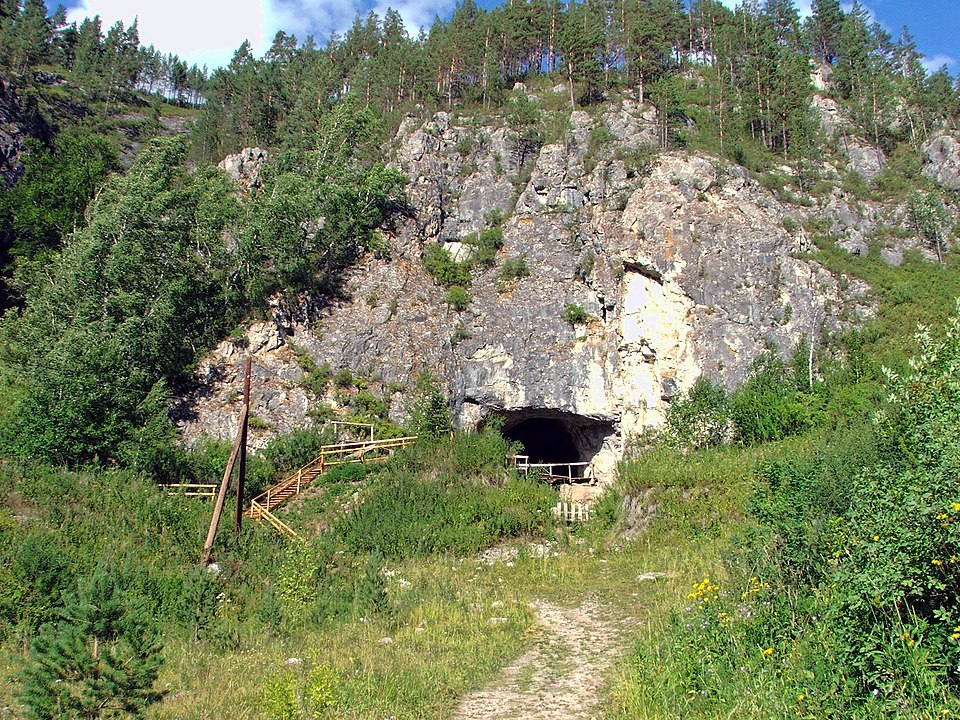
The cave in Siberia, where the first Denisovan fragments were discovered. The word Denisovan was adopted from Denis, the name of a hermit who lived in the cave in the 18th century. Image by Демин Алексей Барнаул, Wikipedia .
Technology has given us a radically different perspective on the human genome’s evolution, with the ability to decode sequences of four key compounds present in the DNA of bones and teeth.
Technology is also leading to greater understanding of how those four compounds in DNA combine, in pairs that rotate around each other in a double helix formation. The cells that make up our bodies receive their operating instructions from that double helix, and the operating instructions encoded in DNA differ for each species.
As the list of our predecessors has grown, our own technological progress has provided evidence that the DNA of various hominin species combined, when communities discovered each other and began to interbreed. Having the ability to sequence the DNA of many species, we now know that the evolution of human DNA involved mixing in the distant past with both Neanderthal and Denisovan DNA, and the Neanderthals also mixed with the Denisovans.
In addition to the Neanderthals and Denisovans, other pre-human species that lived on Earth include Homo floresiensis, Homo luzonensis, homo habilis, and homo erectus.
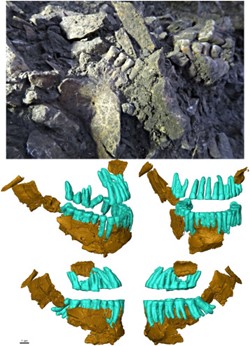
The jaw of “Thorin,” as depicted in the study Long genetic and social isolation in Neanderthals before their extinction.
Knowledge of how the DNA of humans and our ancestors changed over time, and in which global regions change has been most prevalent, yields a wealth of information on how and why our predecessors moved around the planet as they did. A study published in the journal Cell Genomics last September examined the fossil of one Neanderthal individual, who they named ‘Thorin,’ to determine how his genetic line of Neanderthals met its end.
Entitled Long genetic and social isolation in Neanderthals before their extinction, the study analyzed the remains of ‘Thorin’ that were discovered in France and date up to 50,000 years ago. The authors state that the remains were the most complete Neanderthal set found in France since 1979. They show the DNA line of ‘Thorin’ to have had relatively low historical intermixing with other lines.
Understanding which Neanderthal groups mixed with others, in what areas, and during what time periods, could yield significantly greater understanding of the environmental factors that Neanderthals faced. Since little is known of the social structure and history of Neanderthal groups, much focus has been placed on identifying environmental circumstances that could have led to their extinction.
The researchers explain that the genetic line of ‘Thorin’ and his ancestors had diverged from other Neanderthals during what is called the MIS 5 interglacial, “a period in which fast climatic and environmental changes across Eurasia and repopulation by warm adapted fauna occurred throughout the continent.”
The study states that the long time when the genetic lineage of ‘Thorin’ was isolated from other European Neanderthals “raises new questions of relevance to the Neanderthal extinction debate and the types of interactions among Neanderthal populations and also with the earliest H. sapiens arriving in Europe.”
The authors report that in bones of another Neanderthal individual discovered in France, “we found evidence of gene flow with a Neanderthal lineage, diverging prior to the most recent common ancestor of the late Neanderthals.” Surprisingly, the lineage of the Neanderthal individual most closely related to the Siberian Neanderthals from Okladnikov and Chagyrskaya Caves, which means that Neanderthal DNA began to form different branches of the species before evidence to that point had indicated.
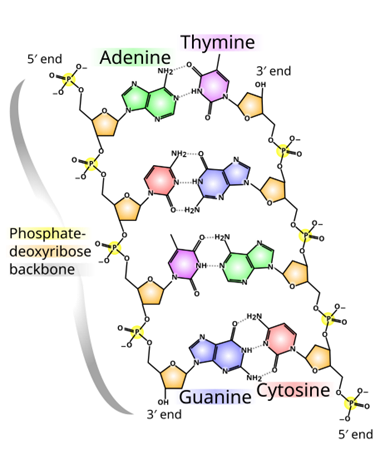
The double helix structure of DNA, with two intertwining strands operating in pairs of the four key compounds adenine, thymine, guanine, and cytosine. Image: Wikipedia .
The paper concludes with a focus on both the absence of gene exchanges among Neanderthal lineages, and the lack of reciprocity in Neanderthal gene exchanges with humans. Human genes had combined with those of Neanderthals, but there’s no evidence of Neanderthals having human genes. This suggests that Neanderthals were less likely to migrate than humans, and so when faced with environmental stresses like drought the population in the region would suffer. Eventually the population would become extinct, unable to sustain itself.
The authors write that the limited scope of gene exchanges “raises questions about the social structures that governed these Neanderthal populations. Our results thus suggest that small, isolated populations with, and potentially without, limited inter-group exchanges, may well represent a surprising and more general feature of Neanderthal social structures.”
Evidence shows social structures among hominins as long ago as 3.2 million years.
Lucy is the name given to the first individual discovered of a species later named Australopithecus afarensis that lived 3.2 million years ago. Lucy’s bones were unearthed in Ethiopia in 1974 and, because they amount to a significant near-forty percent of her entire skeleton, they provide much evidence of what life was like in Lucy’s time.
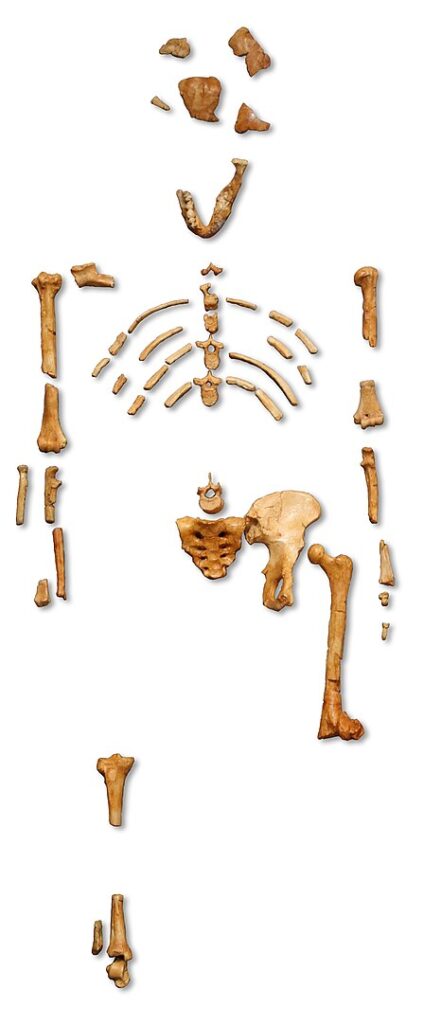
Dating from long before the Neanderthals and Denisovans was “Lucy,” the female hominid from the line of Australopithecus afarensis., who lived 3.8 million years ago. Image: Wikipedia Wikipedia
Since the bones represent so much of Lucy’s structure, scientists could determine body proportions and the relative sizes of limbs. This enabled them to conclude that Lucy walked on two feet just the way we humans now do.
A year after Lucy’s discovery, 200 bones from at least 13 individuals were found in a single location and are considered likely from the same A. afarensis lineage as Lucy. Finding so many individuals in one place indicated that the species lived in communities of males, females, and offspring – as humans do to this day.
Using the latest in computer technology to generate a graphic recreation of Lucy’s mobility based on her body structure, a recently published study in the journal Current Biology concluded that she was a slow runner and spent a significant proportion of her time climbing trees.
When an average human might have a maximum speed of eight metres per second, Lucy likely reached little more than half that, 4.7 metres per second, because of limitations of her body shape.
Science and technology are combining in opening doors to reinterpret the history of the human genome, and with it our understanding of nature’s biological mechanisms for adaptation and reproduction. With the ability to compute so much of a body’s motion and functional ability from only a few fragments of bone and DNA, further discoveries of even more ancient lines could lead to some revolutionary conclusions.
What’s the right lineage to trace back in time, if we want to understand the origin of our DNA?
The studies discussed above are just some examples of new knowledge that continue to paint a very different picture of the origins of life. As technology brings us closer to life’s beginning, it’s also introducing new wrinkles and complexities to a story that might someday yield the secrets of the living universe.
Craving more information? Check out these recommended TQR articles:
- Is There a Looming Digital Divide With Quantum Technology?
- Growing Up Online: Evolving Protections for Children in the Digital World
- Will We Find a Universal Memory for All Physical Scales, From the Tiny Quantum to Giant Stars, in the Geometry of Curves?
- Protecting Sensitive Financial Information From Data Brokers is a Crucial Government Responsibility
- From Stellar Clusters to Cosmic Horizons: Telescopes are Mapping the Edge of the Observable Universe
- Negative Time: Another Curious Wrinkle in the Always Surprising Quantum Universe
Your feedback helps us shape The Quantum Record just for you. Share your thoughts in our quick, 2-minute survey!
☞ Click here to complete our 2-minute survey




